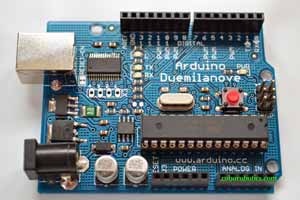Robot Microcontrollers
Embedding a microcontroller in a robot offers on-board decision making, instead of remote control. For a mobile robotic platform, connection to a PC is not practical. Even with a X-bee wi-fi connection, on-board processing is faster with less lag time. In recent years, embedded microcontrollers have become less expensive and, therefore, used by more hobbyists and professionals. Easy programming by connection of a serial port or USB with no special hardware programmer has also encouraged the use of embedded microcontrollers.
8 Bit Robot Microcontrollers
 Currently, Arduino offers the easiest programming. Arduino boards feature the 8 bit Atmel AVR microcontroller. Any one of the Arduino boards, a USB cable, and free Arduino open-source programming application are all that is needed to program an Arduino microcontroller.
Currently, Arduino offers the easiest programming. Arduino boards feature the 8 bit Atmel AVR microcontroller. Any one of the Arduino boards, a USB cable, and free Arduino open-source programming application are all that is needed to program an Arduino microcontroller.
Parallax features the popular 8 bit Basic Stamp series of microcontrollers. A Basic Stamp I or Basic Stamp II is programmed with free software from Parallax and either a Board of Education or Homework board, and a Serial or USB cable (depending on the programming board).
Microchip features the PIC family of microcontrollers that work great for robotics. Microchip has the popular 8-bit PIC MCUs as well as 16-bit and 32-bit PIC microcontrollers. The 8-bit chips are very inexpensive and are programmed with the free MPLAB IDE development software. A separate programmer is needed to program the PIC microchips.
32 Bit Robot Microcontrollers
The .NET Gadgeteer platform, originally developed by the Microsoft Corporation, but now open-source, features a 32 bit ARM processor. Gadgeteer also features rapid prototypiing since it is designed as a solderless system with many different available modules connected to the mainboard. Robot makers will notice the increased performance and versatility when upgrading to the gadgeteer platform from an 8-bit microcontroller.
›More details about the .NET Gadgeteer electronics platform
The Propeller microcontroller, also from Parallax, feature a multicore 32-bit processor. The P8X32A Propeller microcontroller actually features 8, 32-bit cores, resulting in very nice computing capabilities on a small robotics platform. Propeller microcontrollers are programmed using the Spin development software (Viewport), and a Prop Plug or Prop Clip or a Propeller development board.
Microchip features 32-bit PIC processors that have most of the features of the propeller and ARM processors. If you like the price of the PIC microcontrollers or the MPLAB IDE development environment, PIC may be the right choice for a 32-bit processor.

